-
1 of 253523 objects
Clock, organ and mahogany case, c. 1740 1608-c. 1740
Bronze, rock crystal, silver gilt, enamel, mahogany, ebony | 113.0 x 91.0 x 76.0 cm (whole object) | RCIN 30037
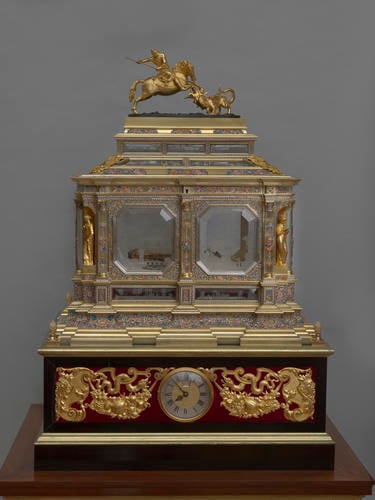
Melchior Baumgartner (1621-86)
The Temple and Oracle of Apollo 1608-c. 1740
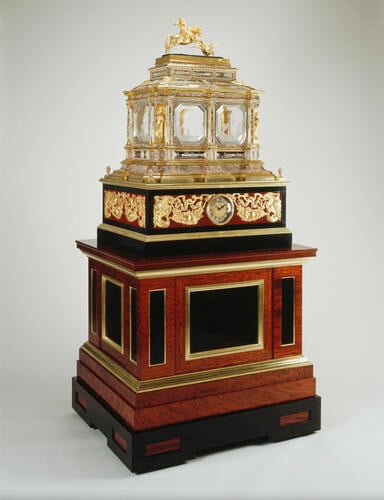
Melchior Baumgartner (1621-86)
The Temple and Oracle of Apollo 1608-c. 1740
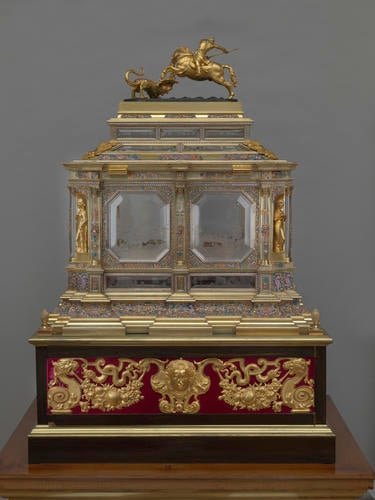
Melchior Baumgartner (1621-86)
The Temple and Oracle of Apollo 1608-c. 1740
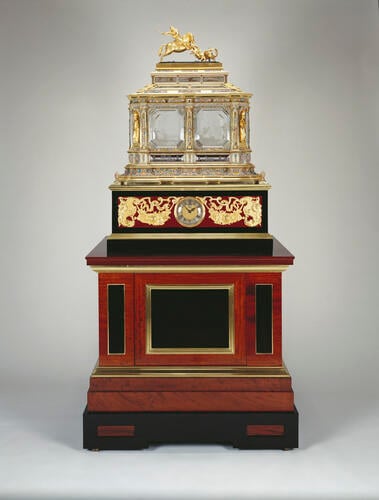
Melchior Baumgartner (1621-86)
The Temple and Oracle of Apollo 1608-c. 1740
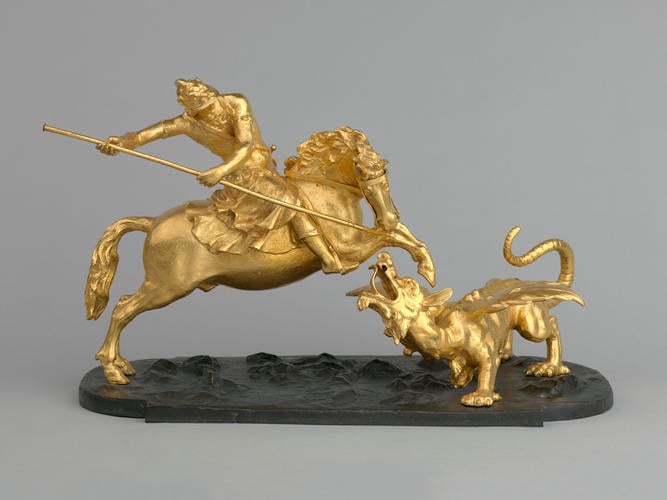
Melchior Baumgartner (1621-86)
Master: The Temple and Oracle of Apollo Item: St. George and the Dragon 1608-c. 1740
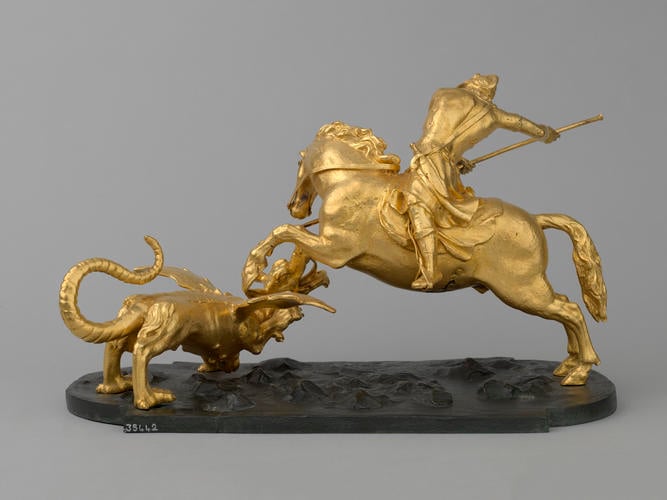
Melchior Baumgartner (1621-86)
Master: The Temple and Oracle of Apollo Item: St. George and the Dragon 1608-c. 1740





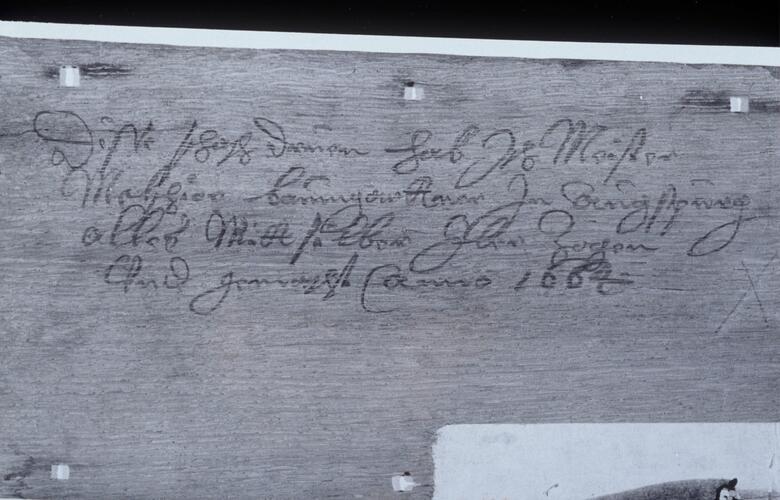


-
This complex piece, combining several generations of additions, was largely the creation of the highly enterprising and ambitious clockmaker Charles Clay. In 1723 Clay had secured the post of Clockmaker to His Majesty’s Board of Works and provided the turret clock for St James’s Palace. He died in 1740.
The piece makes its focal point a rock-crystal casket by the Augsburg goldsmith Melchior Baumgartner, whose inscription (in German) is found on a panel inside the lid ‘I Master Melchior Baumgartner have made this casket in Augsburg and covered it with silver in the year 1664’. Also incorporated in the casket are forty panels of rock crystal, engraved with land- and sea-scapes – with the six principal panels of canted rectangular form and bevelled edges. The panels depict figures and houses in landscapes, while each side panel depicts a shipping scene, one during a calm, the other during a storm. The panels are divided by rock crystal columns with Corinthian capitals in silver-gilt. Almost all remaining areas are decorated by exquisite applied enamelled and silver-gilt mounts of fruiting swags and floral trails. At each angle in a shell-headed niche is a gilt bronze figure of a Greek goddess. Below the casket is a stepped pedestal containing both a clock and organ, which plays ten melodies, all but two of which correspond to settings composed by Handel.
The early history of the Augsburg casket is unknown, although Baumgartner is known to have supplied similarly elaborate pieces to the Bavarian and Brunswick courts . The piece is first noted in a London newspaper advertisement of 27 August 1743, in which Sarah Clay, widow of the clockmaker Charles Clay, announced the exhibition at Cecil Street, off the Strand, of ‘the most curious and valuable piece of clock work left by her late husband’ The Temple and Oracle of Apollo, and charging 1s per person to view. The entire ensemble is described in splendid language as it appears today (less the group of St George & the Dragon and the eponymous Apollo figure, now lost). This announcement suggests that it was through the agency of the maker / entrepreneur Charles Clay (or his widow’s) that the casket, clock-work and organ were assembled into its present, spectacular form.
In George IV's time, the seventeenth-century gilt-bronze group of St George and the Dragon by Francesco Fanelli was added to the top of the casket; and later in the nineteenth century Queen Victoria placed inside it the Bible of the great imperial hero and adventurer General Gordon, murdered at Khartoum in 1885.
Text adapted from The First Georgians: Art and Monarchy 1714 - 1760, London.Provenance
Acquired by either Frederick, Prince of Wales, c. 1743-50, or by Augusta, Princess of Wales, 1759. Frederick Prince of Wales and Princess Augusta (George III’s parents) had a great love of music. They had two weight driven mechanical organ clocks: the Temple and Oracle of Apollo and the Temple of the Grand Monarchies of the World (purchased in 1743 and now displayed at Kensington Palace). Both were created by the clockmaker Charles Clay who established something of a monopoly in this field. This clock plays ten tunes of which five correspond to settings specially arranged by Handel, including airs from operas Xerxes, Arianna and Ottone.
It is not known when this clock entered the collection. It is first recorded in a newspaper advertisement of 1743, three years after Clay’s death, announcing its exhibition to the public by his widow. It is possible that Frederick Prince of Wales bought it at the time of the exhibition, but no bill survives. Alternatively it may have been sold to Princess Augusta in 1759 by the clockmaker George Pyke from whom an inconclusive bill survives.
Alterations in 1822 by Rundell, Bridge and Rundell for George IV included placing the bronze group of St George and the Dragon, attributed to the 17th century sculptor Franceso Fanelli, on top of the casket which he had gilded, and mounting eight gilt bronze mask and scroll plaques on the central section housing the clock.
In 1829 the clock was delivered to Morel & Seddon for the refurbishment of Windsor Castle by George IV. 'organ and clock to be done by Vulliamy', glass for the shade by Ashlin & Collings with gilt metal borders to be supplied by C. Brandt. -
Creator(s)
(clockmaker (case))(restorer)(glass maker)(restorer)(nationality)(nationality)(repairer) -
Medium and techniques
Bronze, rock crystal, silver gilt, enamel, mahogany, ebony
Measurements
113.0 x 91.0 x 76.0 cm (whole object)
17.5 x 29.5 x 14.8 cm (whole object)
191.5 x 91.0 x 76.0 cm (whole object)
Other number(s)
Alternative title(s)
The Temple and Oracle of Apollo
Gilt-bronze statuette, early 17th century
Casket, 1664